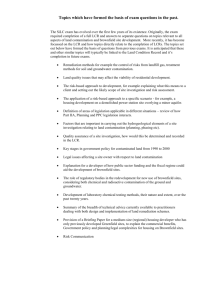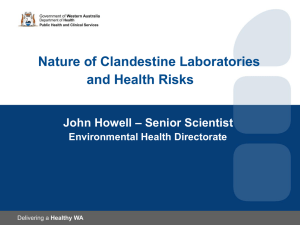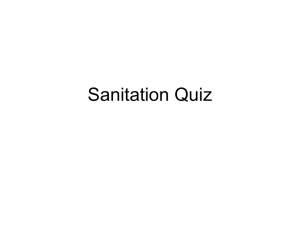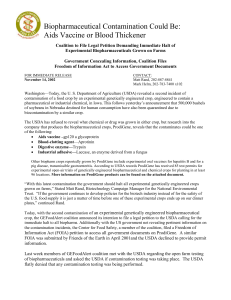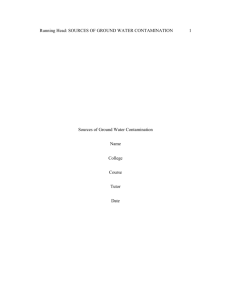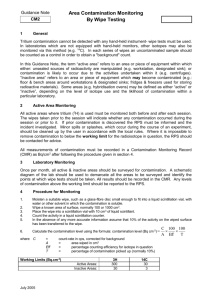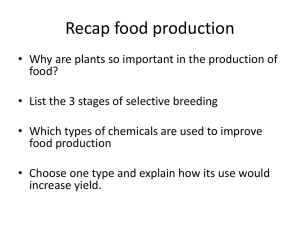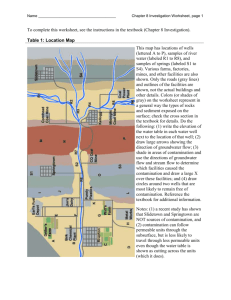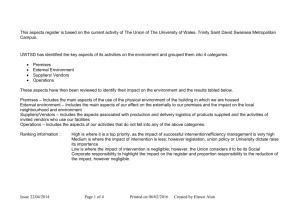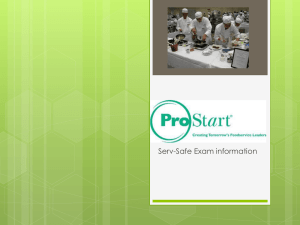Protecting Our Food Supply: Safety, Security,and Defense
advertisement
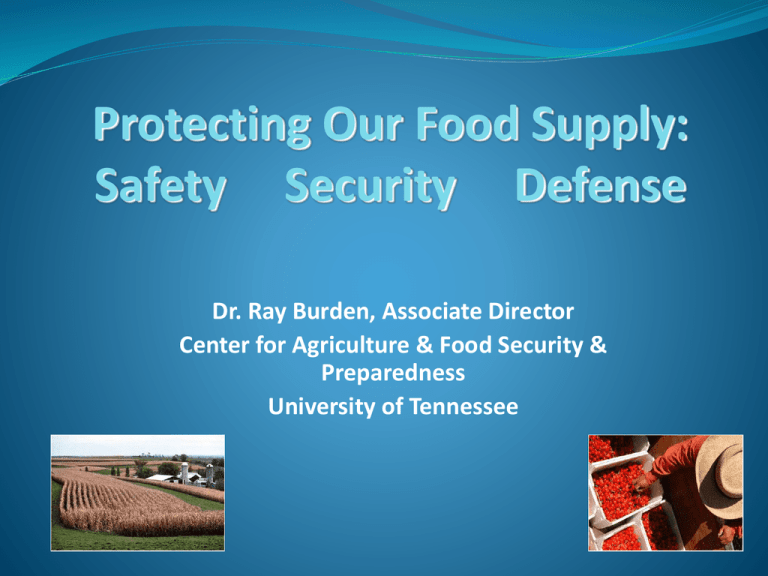
Protecting Our Food Supply: Safety Security Defense Dr. Ray Burden, Associate Director Center for Agriculture & Food Security & Preparedness University of Tennessee Introduction Varied, complex, & changing industry Global in scope LSU Why are we concerned? The Food Processing Industry Prepare raw food products for consumption Processing procedures may be: Simple Washing produce Complex Producing cheese Major Determinants of Processing Procedures Type of food Regulatory requirements Market place/ forces Available technology Farm to Fork Continuum Pre-harvest Food Post-harvest Food Transportation Inputs Processing Farm Production Retail Markets Distribution Consumption Global Food Production Intensive production centers produce food which provides: High-quality Infinite selection Low-priced Valuing Agriculture and the Food Systems Five states (CA, IL, IA, NE, and TX) produce one-third of total U.S. food & agricultural products Agriculture of vital importance to economy of most States Food Supply Chain Food distributed and shipped globally Food travels 1200 or more miles from production to consumption In a day one may easily consume food from over 10 countries Globalization led to increases in: – Trade of food products between nations – Vulnerabilities of food system Your Average American Hot Dog with Chili and Onions… White Pepper - Cambodia Tomato Sauce - CA Yeast - France Wheat - KS Beef - CO Pork - Canada Chili Powder - India Paprika - Thailand www.medwayports.com Diced Onions - Mexico Packaging and Repacking Food products may be moved between facilities where different processing may occur Example: Citrus Grower → Transport → Citrus concentrate → Transport → Final citrus product processed and packaged for sale → Transport → Distributors → Transport →Retail Sale Imported Products and Ingredients Approximately 11 million cargo containers enter the United States every year Only a small percentage are inspected (3-5%) Imported Products and Ingredients US trades with over 150 countries/ territories with products coming into over 300 ports ~ 15% of US food supply by volume imported Increases to 60% if include fresh fruits and vegetables when US production out of season 75% for seafood products Agricultural and Food Supply Systems Agriculture and food systems are an “extensive, open, interconnected, diverse, and complex structure…vulnerable to attack” USDA (HSPD 9) Tommy Thompson Former Secretary of U.S. Department of Health and Human Services (2004) “For the life of me, I cannot understand why the terrorists have not attacked our food supply, because it is so easy to do.” Why are we concerned? Intelligence has shown terrorists have planned to attack agriculture and the food sector Manuals for intentional contamination of food widely available Agriculture and food system “soft targets” Food Terrorism Food or water can carry pathogens, chemicals, and toxins to people to cause illness or death Any incident would cause significant psychological impact 2003 WHO Report Urged governments to create contingency plans to protect against food terrorism Cited foodborne disease outbreaks to show risk “If an unintentional outbreak from one food, such as clams, can affect 300,000 individuals, a concerted, deliberate attack could be devastating, especially if a more dangerous chemical, biological or radionuclear agent was used.” Use of Chemical and Biological Weapons against the Food Supply 1984- Contamination of salad bar in Oregon with Salmonella. 751 persons ill 2003- Contamination of ground beef with nicotine in Michigan. 111 sick, 45 hospitalized 2002- Snack food contaminated with rat poison in China. 300 sick, 40 child deaths Food Threat Agents CDC Category A agents B. anthracis and Clostridium botulinum toxin CDC Category B agents Epsilon toxin of Clostridium perfringens Salmonella species, Escherichia coli O157:H7, Shigella Ricin toxin from Ricinus communis (castor beans) Staphylococcus aureus enterotoxin B Food Vulnerabilities in Transport FSIS food chain assessments highlighted key issues Personnel handling/transporting food Failure to report suspect issues Communication between public and private sector Lack of standard use of seals Food at rest is at risk Import/ Transport Issues Meat & poultry products smuggled into U.S. by ship, truck, air, automobile, mail, & passenger luggage Transport by sea container extremely vulnerable and major mode of transport of illegal drugs into U.S. Import/ Transport Issues Container documentation typically provides only limited details about contents, sender, and ultimate recipient. Goods transported by truck or rail highly vulnerable since difficult to thoroughly inspect. Import/ Transport Issues Port employees may participate in an act of intentional adulteration. GAO has estimated that at port facilities, over 80 percent of cargo theft is perpetrated by personnel whose employment gives them direct access to the cargo. Transportation Vulnerabilities Trucking major form of transporting food both in foreign countries and within U.S Many trucks not sealed with tamper-proof or tamper-evident locks or seals Trucks may make multiple stops to pick up and unload products Transportation Vulnerabilities Recently, in two separate incidents, cocaine found inside packages of ground beef destined for school lunch program. Highlights vulnerability of truck transportation Food Terrorism Direct Effects Human illness or death Mental anguish / Generate fear Decreased productivity or death in animals or crops Product recalls and destruction of product Losses associated with clean up efforts Food Terrorism Indirect Effects Loss of consumer confidence Loss of jobs Trade restrictions Market destabilization Undermine confidence in government USDA 2005 – E. coli O157:H7 outbreak associated with pre-packaged lettuce caused drop in sales Why should we be concerned? Numerous possibilities for contamination exist from processing to shipping Can impact the safety of the food supply Contamination at one point in the system can spread globally with a resulting huge impact in terms of human illness and/or death Plastics chemical can make feed appear more protein-rich Updated 8:50 p.m. ET, Fri., April. 20, 2007 Melamine- Case Study Chemical used in a variety of industrial manufacturing processes Not approved for addition to human or animal foods in the U.S. When added to food products, it elevates the protein content of the product Used as an adulterant for economic benefit in China Melamine- Case Study Contamination of US pet food (wheat gluten) in 2007 Dogs and cats that consumed adulterated pet food developed kidney failure and many died Contaminated infant formula in China in 2008 More than 47,000 infants and young children hospitalized for urinary problems, possible renal tube blockages and kidney stones. Four infant deaths confirmed. FDA Advisories- Possible melamine contamination Topaz Wafer Rolls with Various Cream Fillings G&J Hot Cocoa Stuffer Item 120144 G&J Cocoa items Wonderfarm Variety Assorted Biscuits Sweet Time Christmas Dressy Bear with Chocolate Bar Fresh and Crispy Jacobina Biscuits Koala’s March Crème filled Cookies White Rabbit Candies Mr. Brown Various Blends Instant Coffee Mr. Brown Milk Tea (3-in-1) YILI Brand Milk Drinks Blue Cat Flavored Drinks Infant formula manufactured in China Hydrolyzed leather protein Center for Agriculture & Food Security & Preparedness- University of Tennessee Opened October 16, 2006 Primary focus to assist the nation to protect its critical infrastructure, including agriculture and food supply ~8 million in funded projects Funded projects: DHS, USDA, FDA, TN Dept of Ag, state Homeland Security National Training Programs Agriculture and Food Vulnerability Assessment Importation and Transportation of Food Credentialing of Animal Emergency Responders Geared towards frontline officials and responders- Adult Learners Agriculture and Food Vulnerability Assessment Training Program MGT 332 MGT 337 2 ½ days 1 ½ days Case studies on crops, Subset of MGT 332 animal facilities and food processing Focus on food processing Sharing of Information & Intelligence on the Importation & Transportation of Food Food transportation consistently ranked as one of the most vulnerable links in our food chain 3 components: Web-based course Instructor-led course- 1 day Video for Transportation Industry ILT available January 2011 Food Safety Modernization Act Integrated Food Safety System (IFSS) FDA and USDA’s FSIS Multiple focus points transportation and importation Increase training for food inspectors at all levels Food defense Emphasis on training food inspectors at all levels Food Safety during disasters CAFSP and FSMA Partner with NMSU and U of HI Focus on importation and ethnic foods Central and South America Pacific Rim Cultural competency for inspectors Training for food inspectors during disasters Summary Concerns over the potential for intentional contamination of food are valid Food Protection Safety Security Defense Questions? rwburden@utk.edu 865-974-7230
